
How to perform SEMRUSH Competitor Research in 2022
We use affiliate links. If you purchase something using one of these links, we may receive compensation or commission.

Imagine: it’s your first day on the job at a new company, and your manager asks you to create a new digital marketing strategy. So, you sit down right away and create one from scratch, relying on nothing but your own determination and creative spirit.
That’s how it works… right? Not if you want your digital marketing strategy to be any good. To understand the competition, you need a rock-solid competitor analysis.
What Is SEMRUSH Competitor Research?
SEMRUSH Competitor Research is the process of identifying the strengths and weaknesses of your rivals. In a competitive analysis, you analyze their marketing, pricing, promotion channels, market share, and other details to learn more about each competitor’s marketing strategies.
A competitor analysis can help you:
- Understand your industry and competitive landscape
- Define your unique value proposition
- Reveal actionable benchmarks to evaluate your progress
- Identify rivals’ success strategies
- Hone your marketing strategy to maintain a competitive edge
You can use your findings to create benchmarks, evaluate your current marketing strategy, and even develop a new one.
How to Do a SEMRUSH Competitor Research
When you think about competitor analysis, you probably picture benchmarks like market share, profits, and product pricing. While those are all legitimate and useful, they’re not the only ones you could use.
For example, if you prioritize online performance, website traffic might be your most important metric. In both cases, your primary goal is the same: to figure out how your rival is attracting and keeping the same audience you’re competing for.
Below, we’ve broken competitor analysis into four basic steps:
- Build a list of competitors
- Create competitor profiles
- Identify competitor products, pricing, placement, and promotional strategies
- Pinpoint best practices and create a plan of action
Pro Tip: Before you begin, make sure you know how to keep track of all the data your analysis uncovers. We’ve created an easy-to-use template that you can use as you follow each step of our competitive research workflow.
Step 1: Build A List of Competitors
If you’ve never done a competitor analysis before, the first step is to create a list of all the major players in your niche. This list tells you who you might be competing with for your audience’s attention and gives you an idea of who to focus on throughout your competitor analysis.
You can start building this list using the Market Explorer tool.
First, select “Find Competitors” and enter your domain. This will automatically generate a list of the major players in your space. If you already know your competitors, you may instead choose “Create List” and enter them manually.
The Growth Quadrant widget will show you who you’re competing with online on the Overview report. It will also visualize their relative market positions, audience size, and growth rate.
The Growth Quadrant chart does this by breaking you and your competitors into four basic categories:
- Niche Players: New or small companies with smaller audience size and a low growth rate
- Game Changers: Emerging companies with a comparatively smaller audience size but who are growing quickly
- Leaders: Companies with both a large audience and a rapid growth rate.
- Established Players: Companies with large, established audiences
Make a note of where each competitor stands and how their audience and traffic growth compares to yours. Which players occupy the same quadrant as you? Which are you most concerned about?
Once you’ve identified your key competitors, the next step is to research their online presence through organic, paid, and local searches.
Find Your Organic Competitors
Next, identify your competitors in organic search. These are the ones who appear alongside you in the search results for the keywords you’re targeting. You can find them by manually researching each of your target keywords or using the Organic Research Competitors report.
First, open the Organic Research tool and enter your domain. Then click on the “Competitors” tab. Here, you’ll find the Competitive Positioning Map, which illustrates how powerful each competitor is in your space, based on their traffic and the number of keywords they rank for.
Here, you’ll also find a complete list of organic competitors, sorted by competition level. This metric is calculated based on the number of keywords a competitor ranks on and the number of keywords shared between you and the competitor.

Make a note of which competitors are your biggest competition in organic search and any new names that did not appear in Market Explorer.
Find Your Paid Search Competitors
Next, find your competitors in Paid Search. These are the businesses competing with you for ad space on the exact keywords you’re targeting. Because the same ads do not always appear, it’s helpful to use a tool like the Advertising Research Competitors report during this step.
Like the Organic Research tool, the Competitors report begins with a Competitive Positioning Map, which shows you your biggest paid search competition. Beneath that is a complete list of your paid search competitors, sorted by competition level. Here, you’ll also learn:
- How many paid keywords you have in common with a competitor
- How much paid traffic their ads are driving
- How many organic keywords your competitor ranks for

For the competitors you’re already interested in researching—along with any new ones that interest you—make a note of their competition level, important keywords they’re placing ads on, and how much traffic those ads are driving.
Find Local SEO Competitors
Local search is a cornerstone of any online marketing strategy, whether your clients are nearby or worldwide. That’s because local search isn’t limited to queries like “marketing agencies in Philadelphia” or “restaurants near me.” Instead, a local pack might appear on many different search terms, even if they don’t include a local search phrase.
You can find your local competitors manually by researching your target keywords and noting who appears in the local pack each time. However, the Competitors Discovery Report (part of the Position Tracking tool) can make it easier.
If you’ve never used Position Tracking before, you’ll first need to set up a campaign with a local target (e.g., the city your company is based in). Then head to the Competitors Discovery tab to identify your local competition.
The Competition Map will show you how you stack up against your top competitors based on the number of keywords and average position. Beneath that, you’ll find a complete list of your local competitors, sorted by Share of Voice.
Make a note of which competitors are dominating the local conversation. Then, make sure your website is optimized for local search with up-to-date address and contact information across all your platforms.
Pro Tip: Beating the competition in local search may just be the most efficient first step to gaining a competitive advantage. If you’re not sure where to start, check out this guide on improving your local SEO.
2. Learn Who Your Competitors Are
Now that you’ve built a list of competitors to research, it’s time to learn more about who they are and how they compare to you. We’ll do this by:
- Analyzing market share (how much power or influence they have in your niche)
- Researching their audience (who they’re targeting, and how much your audiences overlap)
- Building a competitor profile (company size, locations, history, and other essential info)
Analyze Market Share Benchmarks
Market share is the portion of a total market controlled by one company. The higher your market share, the more influence you have over the way products are priced, how the public perceives you or your products, and more.
Market share is typically determined by sales numbers or revenue. However, in digital marketing, you might also look at metrics like traffic or the number of active users to determine market share in a way that is relevant to your goals.
To better understand market share in your niche, return to the Market Explorer tool.
Here, you have two options. You can continue using “Find Competitors” as you did earlier in this workflow, or you can manually enter up to 20 competitors from your updated list and analyze those.
Then, scroll down to Domain vs. Market Dynamics on the Overview report. This section analyzes the influence you and your competitors have within your niche, compared to the overall market trends.
Share of Visits breaks down the percentage of total website visits attributed to each competitor in your space. You can view these all together or by channel. Competitors with a higher share of visits get more traffic, meaning they have a larger market share.
If you’re not sure what this means for you, take a look at the Total Traffic Trends graph to the right. This compares your domain’s traffic over time with the total traffic received by all competitors.
Note the share of traffic owned by you and each of your competitors. If you want to take it further, you can break it down by channel or benchmark against the total market traffic.
Understand The Audience
While market share might tell you which competitor has the most significant influence over your audience, it doesn’t tell you who that audience is.
Understanding audience demographics can help you connect with your customers while also creating products and services that effectively address their needs.
You could perform the research yourself through customer questionnaires and surveys for this step. Or you could find out the basics about your market audience more quickly via the Market Explorer Demographics report.
The Demographics report provides a high-level overview of the audience demographics in your niche. This includes:
- Age and Gender Ratios
- Social Media Preferences
- Hobbies & Interests
Later, you can use this data to build an audience persona.
Next, find out how your audience compares to and overlaps with your closest competitors. You can do this in the Audience Insights report in Traffic Analytics.
The Audience Overlap graph will show you how your audience and competitors compare to one another. Here, you’ll be able to see relative audience size, as well as where each one overlaps with the competition.
You’ll also find a list of websites popular with each segment of your shared audience. Make a note of any relevant websites you’re not competing with, as these could be good places to advertise or even partner with.
Next, move to the Traffic Sources report. Here, you can find out:
- Which channels each competitor is using to drive traffic
- The top traffic sources leading the audience to each competitor
- Which websites the audience is most likely to visit after they leave a competitor’s domain

This can tell you how your audience finds your competitors, where else they’re looking for products or services, and what other companies may collect some of their customers.
Build Your Competitor Profiles
Now that you know more about your competitors’ audience and market share, it’s time to round out your competitor profiles by filling in basic company information about them. This provides context that could help you analyze your findings and build a more competitive marketing strategy.
For example, suppose one of your competitors has only been around for a couple of years and has half of the number of employees of a competitor and has raised millions in funding rounds. In that case, they might be a bigger threat than the larger established company.
You can find basic information about your competitors in the Company Info section of the Traffic Analytics Overview report. This includes which categories they operate in, their funding amount, and how many employees they have.
You might also consider manually searching for more details like:
- When they were founded and major milestones
- How they’re structured
- What differentiates them from the pack
- Where they operate
Try to maintain consistent information for each competitor, if possible, to make it easier to compare and analyze. However, if you find a key detail that really stands out, don’t hesitate to include it in your profile.
Once you have all the preliminary insights, it’s time to get to “the 4 Ps” of marketing: product, pricing, placement, and promotion. Exploring these will give you a deeper understanding of your competitors’ marketing strategies.

Identify Top Products and Pricing Strategies
First, take your list of competitors and start a deep dive on each of them.
Take some time to explore their sites and identify:
- Which products or services are featured prominently
- Their pricing strategies, including sales or discounts
- Additional promotions such as referral schemes, free trial offers, or other extra perks
Your competitor might have hundreds of products on their site. Most likely, only a small number of them serve as major audience drivers. To identify your rivals’ top products, use the Top Pages report in the Traffic Analytics tool. To do this, you’ll need to enter your competitor’s domain.
The Top Pages report tells you which pages on a website earn the most traffic. By identifying the most popular product pages on a competitor’s website, you’ll pinpoint which products are most likely to be major audience drivers.
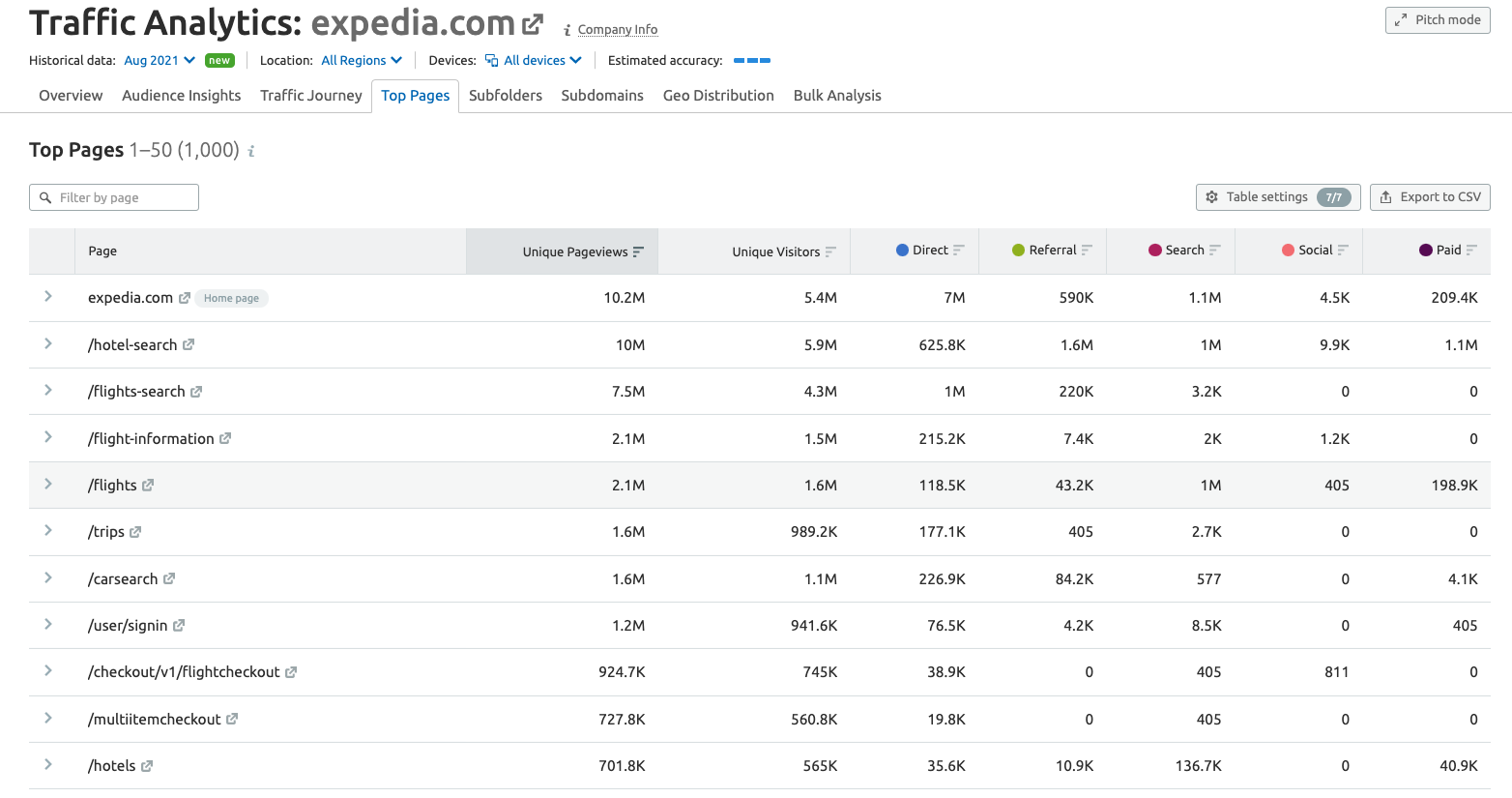
Once you’ve identified your competitor’s top product pages, take a closer look at the products themselves. Because each offering is unique, these might be difficult to compare directly. Instead, note all of each one’s significant features. Then ask yourself:
- Are these products successful?
- Are any of these products established, market leaders?
- Is my competitor heavily invested in launching new products?
- Are they discontinuing any products or offering substantial discounts?
If you want to learn even more about how your competitor promotes their essential products, enter their domain into the Advertising Research tool. Then analyze their ad copy for any special pricing, promotions, and the type of language they use to communicate them.
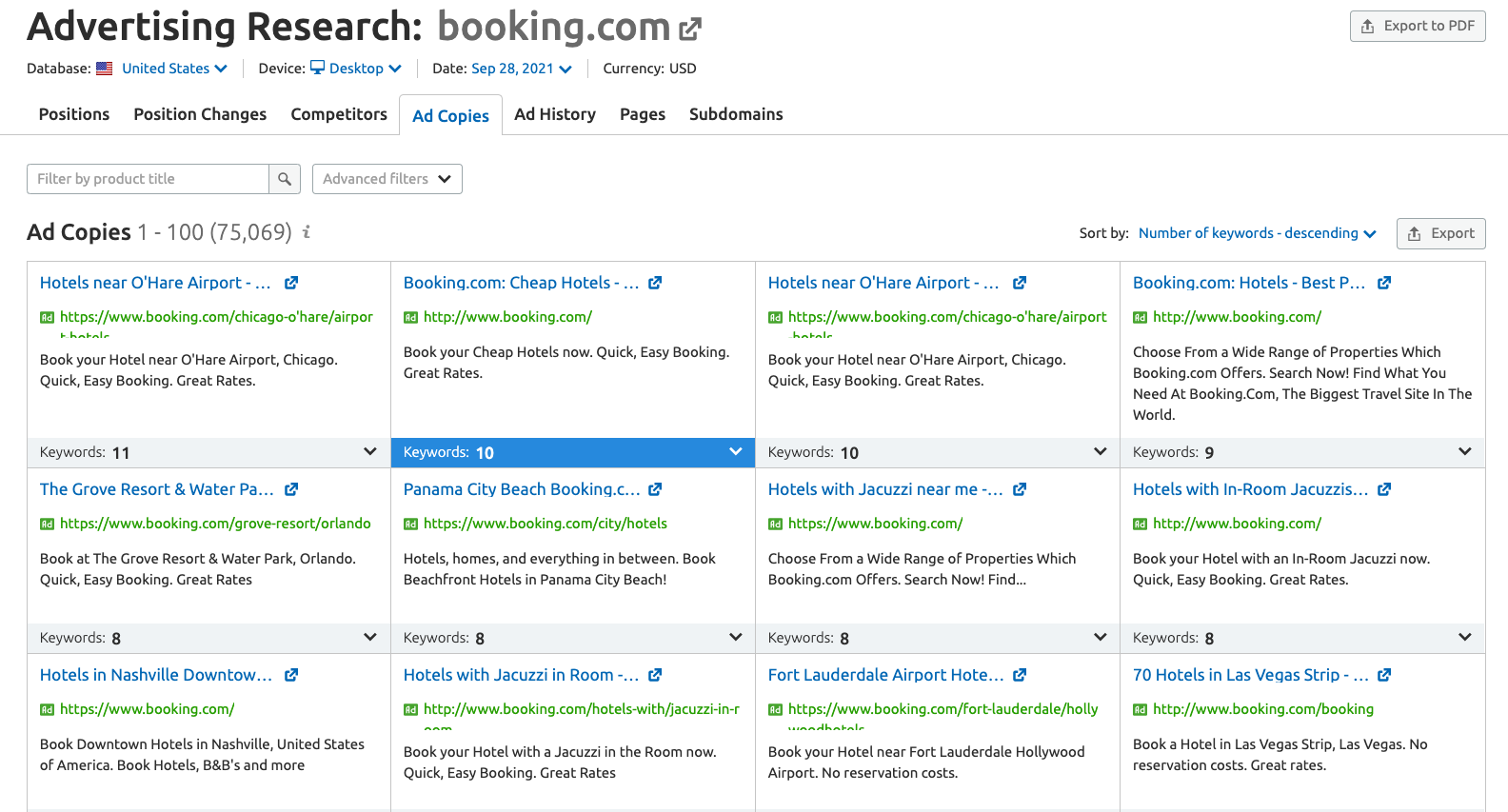
Repeat this process for each of your competitors. As you do, pay close attention to the types of products or services that are most successful for each competitor, and compare that information with your own. Do you notice any trends? If so, make a note of it.
Dissect Competitors’ Promotion and Placement
Next, analyze your competitors’ promotional channels to find out how they’re reaching their audience. Not only can this help you understand their promotion strategy because your audiences likely overlap, but this can also tell you which channels are likely to resonate with them.
Take a Trial and Get More Out of SEMrush

Here are a few conclusions you may draw from each channel:
- Direct: If your competitor relies on this, they probably have strong brand awareness. Users already know the brand name to navigate their site directly. They may also be conducting offline marketing.
- Referral: Your competitor likely has a strong backlink profile or places banner ads on other sites. They probably have strong digital PR and maybe posting content on other platforms.
- Search: Your competitor is focused on-page technical SEO and content optimization. You can analyze their content marketing and identify their top pages.
- Social: Your competitor likely has a solid social media presence with an engaged audience. It may be a good idea to investigate which platforms they use most.
- Paid: Your competitor probably has a strong advertising budget, particularly for paid search. You may want to investigate which keywords they’re bidding on and analyze their ad copy.
Using the Market Explorer Benchmarking report, you can compare the traffic generation and social media distribution strategies of up to five competitors and benchmark those strategies against the market as a whole.

If you’re researching more than four competitors, you can repeat this process for all of them.
Next, analyze their ad placement. This can tell you more about using the above distribution channels to reach their audience. This is crucial to online marketing because it impacts:
- How much you spend on advertising
- How much traffic you’re able to generate
- How effectively you target your audience
- How familiar your prospective audience is with your brand
You can uncover your competitor’s ad placement by returning to Traffic Analytics and using the Traffic Journey Details report.
Select “Referring Sites” to uncover which websites send traffic to your competitor. Sites that send a lot of traffic to your competitor may be a good place for you to advertise.
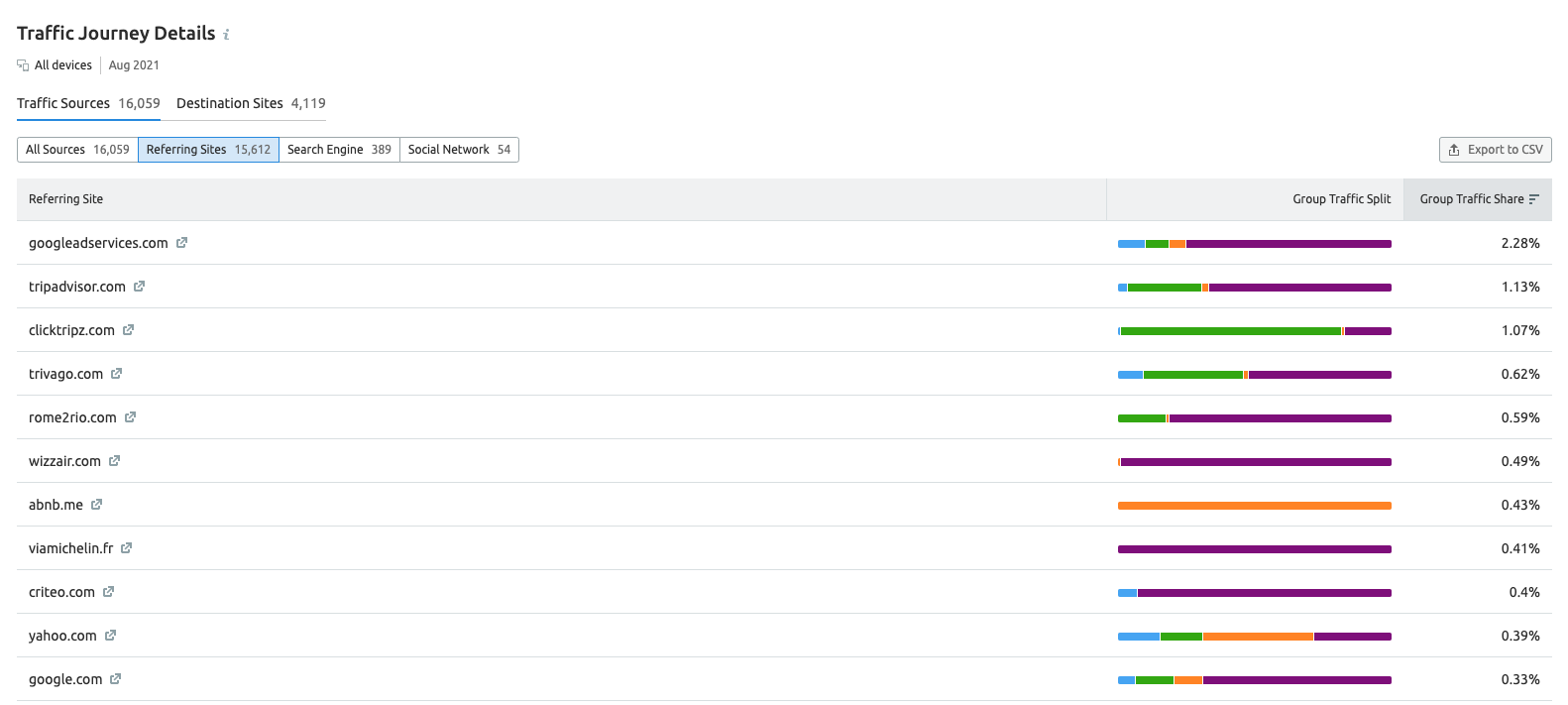
4. Pinpoint Best Practices and Create a Plan of Action
Now that you’ve completed your Competitor Analysis Template, it’s time to turn your observations into actionable insights.
You could approach this in many different ways, depending on your needs. For example, a simple SWOT analysis might be sufficient if you need something straightforward and to-the-point. On the other hand, if you prefer a more in-depth approach, you might use Porter’s Five Forces Model.
Whichever approach you use, make sure you keep these questions in mind:
- What are my most important priorities?
- What are my biggest strengths and weaknesses?
- What does my audience want?
- Which of my competitors’ strategies seems to work the best? Am I doing that?
Check out our blog post on competitive analysis frameworks and tools if you want to learn more.
Last but not least, revisit your analysis regularly to update your findings. This way, you can stay on top of the trends and keep beating the competition.
Conclusion
Competitor analysis is a crucial aspect of marketing. Without competitor analysis, a business might not understand which channels to target or what strategy can help them generate conversions.
Use the guide above to discover, track and better understand your competitors, so you can navigate through your market with ease.







